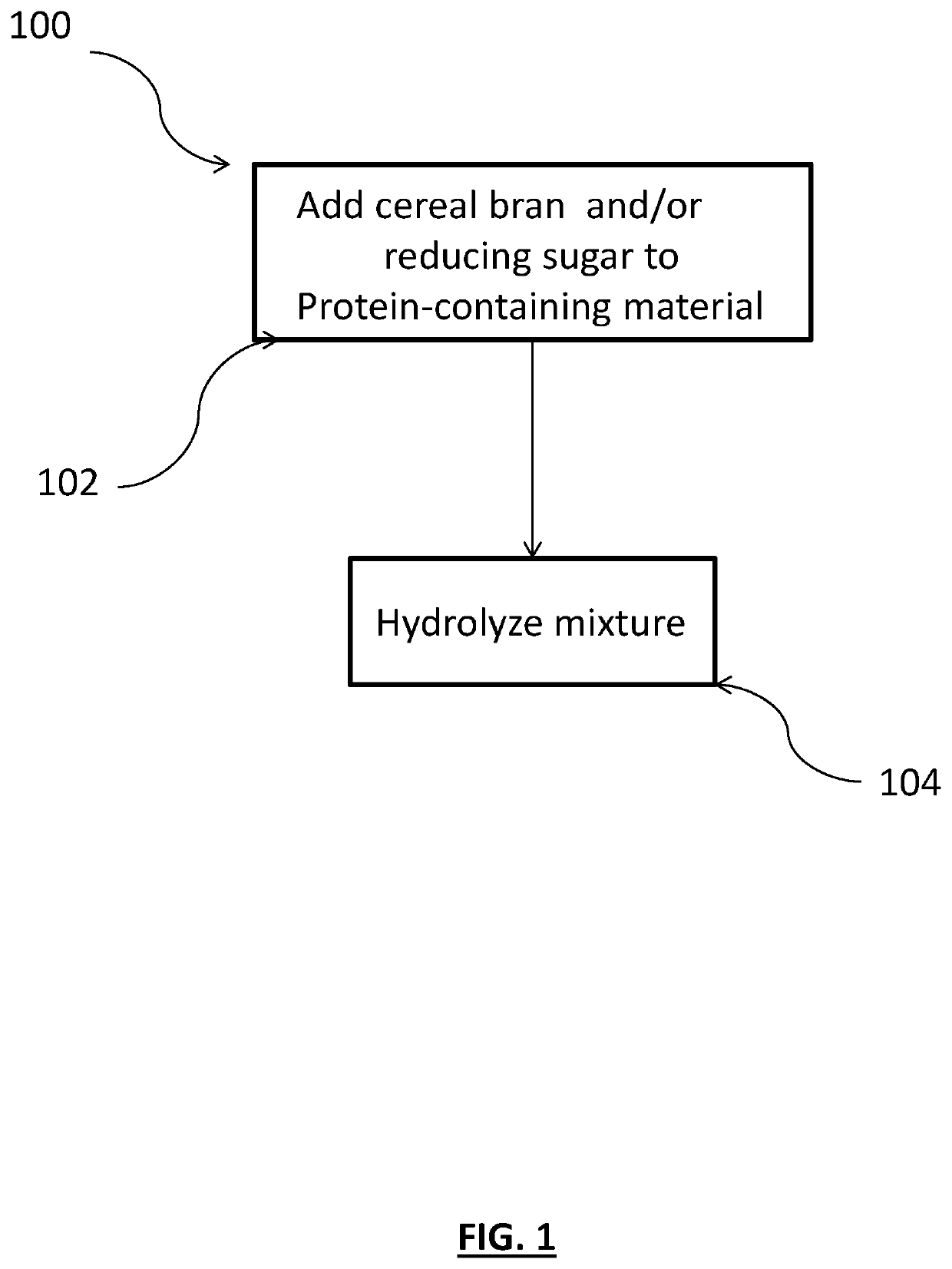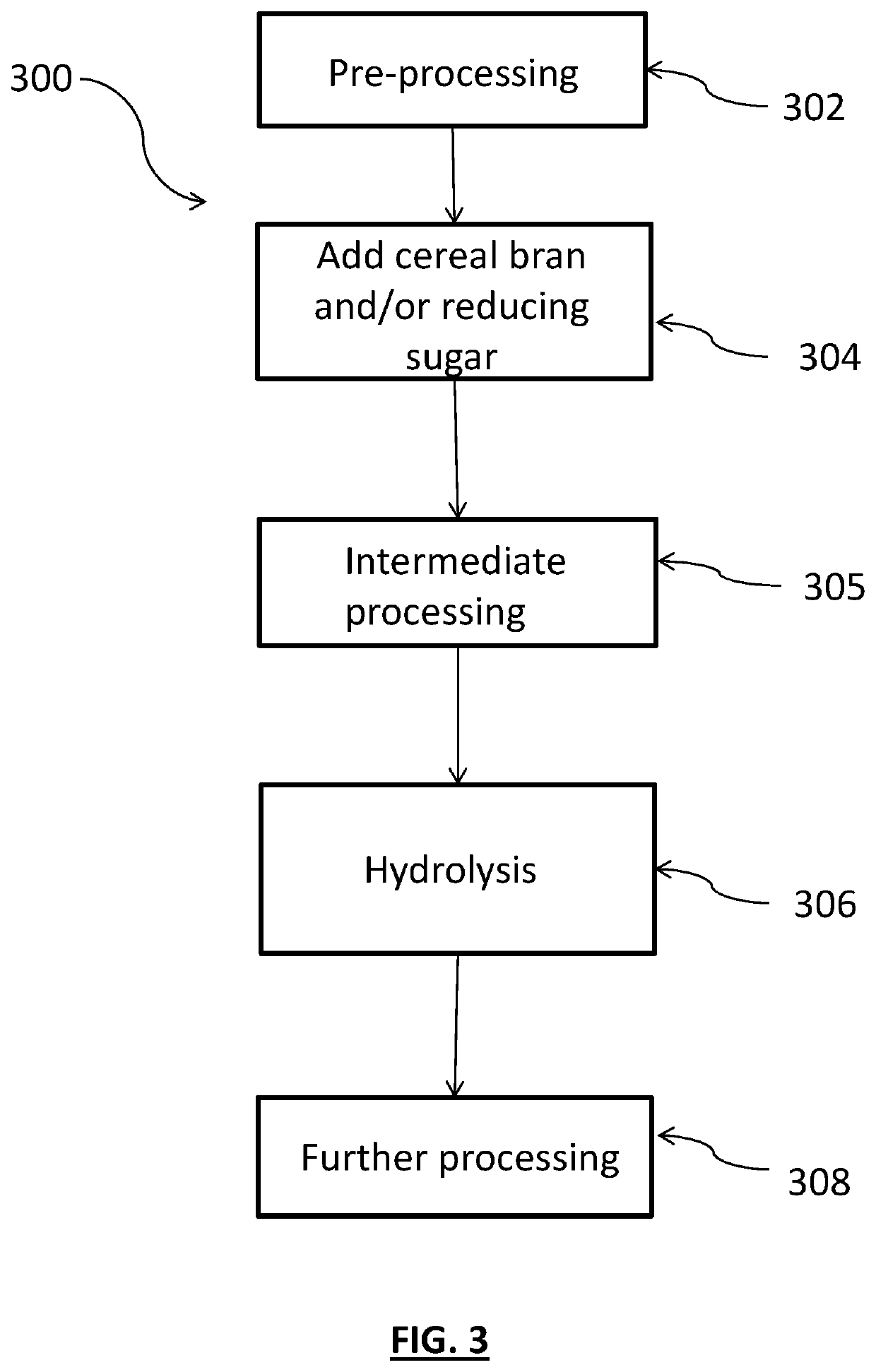Methods for producing feather-based food products
a food product and feather technology, applied in the field of methods for producing feather-based food products, can solve the problems of affecting the digestibility of animal feed, affecting the taste of meat protein, and already expensive food ingredients such as meat protein, and achieve the effect of minimizing the production of unpleasant odors and minimal unpleasant odors
- Summary
- Abstract
- Description
- Claims
- Application Information
AI Technical Summary
Benefits of technology
Problems solved by technology
Method used
Image
Examples
example 1
Pre-Treatment (Optional)
[0064]1818.2 g of sodium metabisulfite are dissolved in 10 kg of water to make a solution to he sprayed onto the surface of approximately 2000 pounds of feathers. The solution is sprayed onto layers of feathers as they are placed into a plastic container for transport. The packaged feathers are subjected to steam treatment for approximately 15 minutes to achieve a minimum temperature of 180° F. After this treatment, the feathers are transported and stored appropriately prior to the steam hydrolysis step. Optionally, the desired cereal bran and / or reducing sugar, in the desired amount could be added to the pretreatment solution or directly to the feathers prior to pre-treatment and packaging.
Steam Hydrolysis
[0065]120 kg of the raw or pre-treated feathers alone (comparative), or with 12 kg added defatted rice bran (inventive) are placed into a pilot batch steam hydrolyzer. The batch hydrolyzer has a dual plate mounted on a single shaft to mix the feathers durin...
example 2
Laboratory Scale Screening
[0071]One or more sugars or cereal bran, 200 g of feathermeal hydrolysates and 200 g water were mixed and reacted in a Parr reactor (Parr Instrument Co., Moline Ill.) at 120° C. for 30 minutes. Sensors evaluation was conducted on the processed wet samples by a panel of 3 human evaluators familiar with the off-odors generated by conventional feather hydrolysis, but not using any particular standardized sensory methodology. Samples were ranked on a scale of 1 to 5 where 5 is the best smelling (defined as mild and / or pleasant) find 1 is the worst smelling (defined as strong and / or unpleasant smelling). Sugar amounts, cereal bran amounts and sensory ratings are shown below in Table 1.
TABLE 1SampleFeatherCerealSensoryIDTypeSugar wt. %Bran, wt. %Rating8 / 2-1Hydrolysate——1.29 / 2-2HydrolysateXylose, 0.5 wt. %—2.312 / 2-3HydrolysateHFCS1, 0.5 wt. %—1.713 / 2-4HydrolysateHFCS + Xylose,—1.00.5 wt. % each14 / 2-5HydrolysateBrewer's yeast,—1.00.5 wt. %23 / 2-6HydrolysateXylose, 1...
example 3
[0072]Sugar or cereal bran was mixed with raw feathers in the amounts shown in Table 2. Each sample was processed in a Littleford Day Pilot Hydrolyzer at 140° C., 40 PSI for 15 minutes. Hydrolyzed feathers were comminuted using a Comitrol® model 1700 processor (Urschel Laboratories, Inc.) and dried using a Ring dryer at a drying temperature of 82° C. Sensory evaluation was conducted on the dried samples by a panel of 3 human evaluators, familiar with the off-odors generated by conventional feather hydrolysis, but without using any particular standardized sensory methodology. Samples were ranked on a scale of 1 to 5 where 5 is the best smelling (defined as mild and / or pleasant) and 1 is the worst smelling (defined as strong and / or unpleasant smelling). The resulting sensory ratings are shown below in Table 2.
TABLE 2RawInitialFinalSam-AdditivefeatherMois-Mois-pleamountamountturetureSensoryIDAdditive(kg)(kg)(%)(%)Rating3-1D-xylose0.151564.869.22.53-2HFCS0.151571.670.42...
PUM
| Property | Measurement | Unit |
|---|---|---|
| pressure | aaaaa | aaaaa |
| pressure | aaaaa | aaaaa |
| pressure | aaaaa | aaaaa |
Abstract
Description
Claims
Application Information
 Login to View More
Login to View More - R&D
- Intellectual Property
- Life Sciences
- Materials
- Tech Scout
- Unparalleled Data Quality
- Higher Quality Content
- 60% Fewer Hallucinations
Browse by: Latest US Patents, China's latest patents, Technical Efficacy Thesaurus, Application Domain, Technology Topic, Popular Technical Reports.
© 2025 PatSnap. All rights reserved.Legal|Privacy policy|Modern Slavery Act Transparency Statement|Sitemap|About US| Contact US: help@patsnap.com



